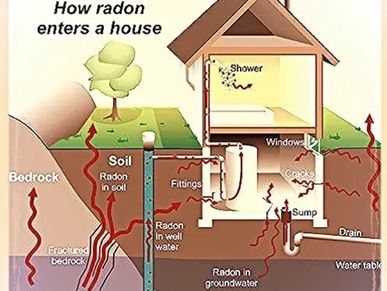Heating season is coming. Time to ensure your home's radon level is safe.
Why testing for radon reduces your risk of lung
Uranium emitting radon gas which then decays to radioactive alpha particles that you breathe.
Radon is a cancer-causing, radioactive gas that is produced naturally from the decay of Uranium. It is distributed throughout the soil and rocks in the earth's crust. Radon gas is invisible, odourless and tasteless. Concentrations of radon are normally low outdoors but can build up indoors where the gas becomes confined and decays to radioactive alpha particles called radon progeny or radon daughters. When inhaled, these alpha particles are deposited in the lungs where they release bursts of radioactive energy which kills live cells and can also genetically affect the DNA of lung cells and tissue. At some later date these damaged cells can become the beginning phase of developing lung cancer.
When radon is confined to enclosed or poorly ventilated spaces, it can accumulate to extremely high levels. Radon levels are generally highest in basements and crawl spaces because these areas are nearest to the source and are usually poorly ventilated. In the open air, the amount of radon gas is very small and does not pose a health risk.
Why should I be concerned when breathing radioactive alpha particles?

- There is no known threshold below which radon exposure carries no risk. The lower the radon concentration is the lower the risk.
- Damage to a cell from the release of radioactive energy from alpha particles in your lungs
- Cell can die
- Cell can repair itself
- DNA incorporates an error, creates abnormal cell, produces a LUNG TUMOR
Radon is a Class A carcinogen, this means that it causes cancer in humans.
Don't let the second leading cause of lung cancer stand in your way of living a long healthy life.
TEST FOR RADON and get peace of mind !
How Radon Migrates Into Your Home.

Radon, being a gas can migrate through small spaces (voids) in the soil and rock. It can seep into a home or building undetected through dirt, floor cracks, sump pits, basement floor drains, around jack posts, foundation cracks and any other opening that would allow gas to flow. Concrete block walls are particularly porous allowing radon to migrate in.
Atmospheric air pressure inside a building is usually lower than the surrounding soil and foundation. As a result, this allows radon and other dangerous soil gases to be drawn into the building through openings in the foundation where it is in contact with the ground.
Radon levels can vary from area to area, home to home and even apartment to apartment. House construction can also affect radon levels. However, radon can be a problem in all types of homes: old homes, new homes, drafty homes, insulated homes, homes with basements and homes without basements.
Radon In Well Water

Most of the radon in indoor air comes from the soil underneath the home or building. However, radon gas can also dissolve and accumulate in water from underground sources (ground water), such as wells. When water that contains radon is used in the home for showering, washing dishes, and cooking, radon gas escapes from the water and goes into the air similar to carbonated soda drinks where dissolved carbon dioxide in the soda is released into the air when you open the lid. Radon is not a concern in water that comes from lakes, rivers, and reservoirs (surface water), because the radon is released into the air before it ever reaches your tap. Only about 1-2 percent of radon in the air comes from drinking water.
Radon In Granite Countertops
Radon Potential Maps of Ontario and Canada

The question about the presence of radon in granite countertops is not new. In recent times the issue has received more exposure, due in part to media attention and the growth in granite's popularity as a countertop choice.
Any type of rock could contain naturally occurring radioactive elements like radium, uranium and thorium. Some pieces of granite may contain more of these elements than others.
If present, these radioactive elements will decay into radon which may be released from the granite over time. However, since granite is generally not very porous, less radon is likely to escape from it than from a more porous stone such as sandstone. It’s important to know that radon originating in the soil beneath homes is a more common problem and is a far larger public health risk than radon from granite building materials. Also, any radon from granite countertops in kitchens or bathrooms is likely to be diluted in the typical home since those rooms are usually well ventilated.
It is extremely unlikely that granite countertops in homes could increase the radiation dose above the normal natural background that comes from soil and rocks.
Radon Potential Maps of Ontario and Canada
Radon Potential Maps of Ontario and Canada

No matter where you live in CANADA, coast to coast to coast, radon gas will be present. The only way to know if you are being exposed to high levels of "RADON GAS IS TO TEST"
Know Your Number
Health Canada Radon Mitigation Recommendations
- Effective October 31, 2024, Health Canada has revised the Radon Action Guideline recommending that all buildings with radon levels greater than 200 Bq/m3 in the normal occupancy area be mitigated within one year to reduce the radon concentration as much as is practical.
Algoma Radon Testing would like to wish you a very Happy Holiday Season. May 2026 be a year of good health and good memories.